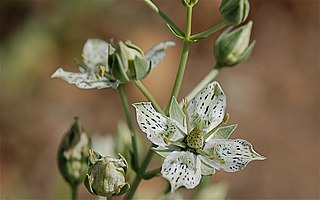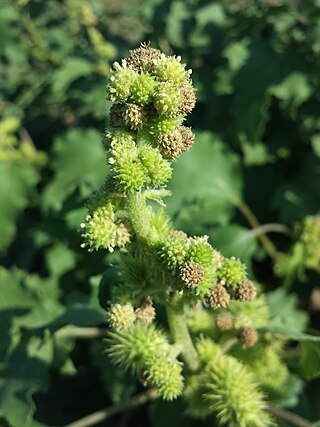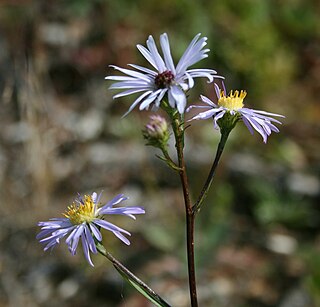
Campanula is the type genus of the Campanulaceae family of flowering plants. Campanula are commonly known as bellflowers and take both their common and scientific names from the bell-shaped flowers—campanula is Latin for "little bell".

Ravenella exigua, the chaparral bellflower, rock harebell, or Rattan campanula, is an annual flowering plant in the bellflower family Campanulaceae.

Lithospermum incisum is a species of flowering plant in the borage family known by several common names, including fringed puccoon, narrowleaf stoneseed, fringed gromwell, narrowleaf puccoon, and plains stoneseed. It is native to much of central Canada and the United States, where it is known from many types of habitat, but particularly piñon-juniper woodland. It is a hairy perennial herb growing from a narrow brown to black taproot and woody caudex. It produces a cluster of stems up to about 30 centimeters long. The stems are lined with narrow, pointed leaves up to 6 centimeters long. The slender, trumpet-shaped flowers are pale to bright yellow or gold, and may approach 4 centimeters long. The corolla face is 1 to 2 centimeters wide, its lobes sometimes ruffled. The smaller cleistogamous (closed) flowers are the main producers of seed.

Collinsia parryi is a species of flowering plant in the plantain family known by the common name Parry's blue eyed Mary. It is endemic to central and southern California, where it is found in the southern Coast Ranges and in the Transverse Ranges north and east of Los Angeles.

Chorizanthe parryi is a species of flowering plant in the buckwheat family known by the common name Parry's spineflower and San Bernardino spineflower.

Atriplex argentea is a species of saltbush known by the common names silverscale saltbush and silver orache. It is native to western North America from southern Canada to northern Mexico, where it grows in many types of habitat, generally on saline soils.
Calyptridium parryi, synonym Cistanthe parryi, is a species of flowering plant in the family Montiaceae. It is known by the common name Parry's pussypaws. It is native to the southwestern United States and Baja California. It is a small annual herb producing spreading stems up to about 11 centimeters long. There is a basal rosette of small, thick, spoon-shaped leaves no more than about 3 centimeters long, with many along the stems as well. The inflorescence is a cluster a few centimeters wide, with each bearing three white petals surrounded by a few thin sepals. The fruit is a capsule less than a centimeter wide.

Campanula shetleri is a rare species of bellflower known by the common name Castle Crags bellflower. The plant is named for Castle Crags, a mountain formation in its limited native range, within the Shasta-Trinity National Forest.

Ceanothus parryi, with the common name Parry ceanothus, is a species of shrub in the buckthorn family Rhamnaceae. It is native to Oregon and northern California, where it grows in the canyons of coastal mountain ranges.

Campanula uniflora, known commonly as arctic bellflower and arctic harebell, is a short and slender rhizomatous perennial in the bellflower family Campanulaceae. It is distributed in arctic North America, including the Rocky Mountains and Greenland, in the Asian part of Beringia and in Iceland, Svalbard, the Scandes Mountains and Novaja Zemlja.

Frasera parryi is a species of flowering plant in the gentian family known by the common name Coahuila frasera.

Pectis papposa is a species of flowering plant in the family Asteraceae. It is native to North America, where it occurs in the southwestern United States as far east as Texas, and in northern Mexico. Common names include cinchweed, common chinchweed, many-bristle chinchweed, and many-bristle fetid-marigold.
This is a list of plants and how they are used in Zuni culture.

Astragalus amphioxys, common name crescent milkvetch, is a plant found in the American southwest, including the whole of Utah, the southeast part of Nevada, the north part of Arizona, the western part of Colorado, the northwestern part of New Mexico, and one county in Texas. It was first described by Asa Gray in 1878.

Croton texensis,commonly known as Texas croton, goat weed, skunk weed, and doveweed, is a species of plant found in the United States.
Dalea lasiathera, the purple prairieclover, is a plant from the Southwestern United States.

Hymenoxys richardsonii, the pingue hymenoxys or pingue rubberweed, is a North American species of plants in the sunflower family. It is widespread across the western United States and western Canada from Arizona, New Mexico, and western Texas north as far as Alberta and Saskatchewan.
Hieracium parryi is a North American plant species in the tribe Cichorieae within the family Asteraceae. It grows only in the western United States, in southwestern Oregon and northeastern California. It is commonly known as woollyweed.

Xanthium orientale is a species of annual plant of the daisy family Asteraceae.

Symphyotrichum foliaceum is a species of flowering plant in the family Asteraceae native to western North America. Commonly known as leafy aster, leafy-bracted aster, and alpine leafybract aster, it is a perennial, herbaceous plant that may reach 10 to 60 centimeters in height. Its flowers have violet to purple ray florets and yellow disk florets. Four varieties were accepted as of July 2021 by Plants of the World Online (POWO), as follows: S. foliaceum var. apricum, S. foliaceum var. canbyi, S. foliaceum var. cusickii, and S. foliaceum var. parryi. The autonym is S. foliaceum var. foliaceum.

















